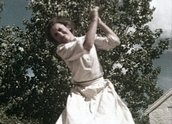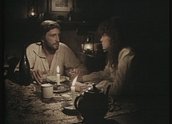


All the Rivers Run (1983)
Synopsis
This is a four-part mini-series filmed on 16mm, based on the best-selling novel of the same name by Nancy Cato.
In the dark pre-dawn a young Englishwoman, Philadelphia Gordon – ‘Delie’ (Sigrid Thornton) – is tossed onto Australian shores by the storm that drowns the rest of her immediate family. She is helped to shore by the only other survivor of the shipwreck, the crusty old seaman Tom Critchley (Gus Mercurio). Delie is taken in by her kindly Uncle Charles (Charles Tingwell) and termagant Aunt Hester (Dinah Shearing) who live on a small farm on the Murray River close to the great inland port of Echuca. The year is 1892. The series follows Delie for the next decade or so of her life, through the difficulties of adolescent love and her early rebellion against conformity, to her maturity as a mother, wife and working woman. She attains commercial and critical success as a painter and earns her Master’s Certificate to become the first female riverboat captain on the Murray; both achievements of considerable note in areas that were, at that time, overwhelmingly male dominated.
The TV adaptation places less emphasis on her passion for art or personal identification with the river than on her deep and lasting attraction to the charismatic Brenton Edwards (John Waters), her partner in the riverboat Philadelphia and eventually her partner in life.
Curator’s notes
‘All the rivers run into the sea; yet the sea is not full: unto the place from whence the rivers come, thither they return again’ Ecclesiastes 1:7.
The verse not only provides a title for Nancy Cato’s 1958 novel, it informs the whole book, giving it structure, form and metaphor. Within this concept of the circularity of all life, the writer explores universal themes as applied to Australian society: the value we place on art and intellectual life; the dispossession of Indigenous Australians; the need for conservation and water management; the stifling nature of domestic drudgery; the moral dilemma of passive euthanasia; and the brutalising effects of isolation. It is adult stuff, not always palatable but still pertinent today.
The series is substantially different, aimed squarely at a family audience. The darkest elements are eliminated and the stories telescoped to focus on the sunnier days of Brenton and Delie’s marriage. However it is unlikely that the screen version would have been as widely successful if the adaptation (by Alan Hardy and Vince Moran) had not emphasised the romance, both human and scenic. The story they chose to tell is no less enduring than the original, just safer: the pain of loss and the joys of love and friendship, the beauty and treachery of the Australian landscape are themes that will never go out of fashion.
Producer Alan Hardy, in acknowledging the difficulties of adapting Nancy Cato’s great, sweeping saga, says that it was nevertheless ‘the strength of the material, background and characters that made it shootable’. The series missed out on the Logie for Best Series in 1984 because it ran up against The Dismissal (1983), but it won a swag of awards in all areas of production and has arguably been watched by more people, more often, than any other Australian mini-series of the prolific eighties.
The charismatic coupling of Sigrid Thornton and John Waters definitely contributed to this success as did the fine work by DOP David Connell, film editors Phil Read and Ralph Strasser and art director Ted Stolfo’s team. The storm sequence at the very beginning, for example, could hardly be better done today. The cast is packed with luminaries but there are three performances of particular note: Carol Burns (Mrs Slope) for a powerful portrayal of female stoicism; Darius Perkins (Ben) for a naturalness that belies his underlying skill; and Diane Craig (Miss Barrett), whose extraordinary beauty is matched by an iron discipline.
Crawford Productions was founded in 1945 by Hector and Dorothy Crawford to produce drama, light entertainment and educational programs for radio. Their many successes in radio include the massively popular D24, quite possibly the only commercially aired police drama ever sponsored by an actual police force, the Victoria Police.
On the advent of television in Australia in 1956, Crawfords became a dominant force in the new medium, particularly in the area of series drama where a central concept and a nucleus of ‘regular’ characters provide a framework within which the individual, self-contained stories of ‘guest’ characters are told. A prime example of this is Homicide (1964-76).
Then, in June 1981, the Federal Government introduced a private investment incentive scheme based on tax benefits, to encourage the making of film and television with high production values. The scheme was nicknamed '10BA’, after the clause that referred to the applicable tax concessions, and it ushered in a decade of remarkable television in the form of the ‘mini-series’.
Since 10BA could not be used to finance serial or series television, which the pundits no doubt considered was doing very nicely on its own, the industry needed to source stories that were big enough thematically to attract and hold an audience over several weeks but which nevertheless came to a conclusive end within the time limit allowed (13 hours originally, later reduced to eight). An obvious solution was to adapt a best-selling book and producers leapt at the opportunity to revisit much-loved stories from Australian literature.
All the Rivers Run was first broadcast on the Seven Network in October 1983 as an eight-hour series in four parts. The first episode had the highest ratings ever achieved by a drama series in Victoria. The series was pre-sold to American network HBO and the US version, cut back to six commercial hours, was released on DVD. A quarter of a century after it was filmed, the DVD of the series continues to be a bestseller at the Wharf tourist precinct in Echuca.
- Overview
- Curator’s notes
- Video 3 clips
- Principal credits
- Find a copy
- Make a comment
- Map
- Add your review



